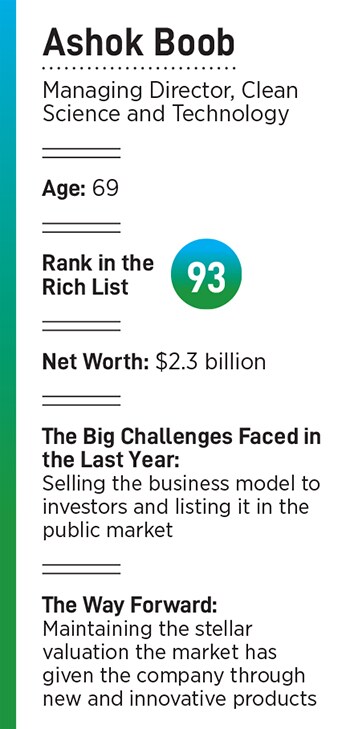
Cleaner chemistry: Ashok Boob, and turning entrepreneur at 54
By focusing on a differentiated manufacturing process Ashok Boob's Clean Science and Technology has grown rapidly and has a long runway ahead
 Ashok Boob (seated) with brother Krishnakumar Boob (standing, centre), son Parth Maheshwari (standing, left) and nephew Siddharth Sikchi
Ashok Boob (seated) with brother Krishnakumar Boob (standing, centre), son Parth Maheshwari (standing, left) and nephew Siddharth Sikchi
Image: Anirudha Karmarkar for Forbes India
At 54, one thinks more about retirement than the next big thing. Not Ashok Boob.
In 2006, soon after he turned 54, he turned entrepreneur.
He’d spent his entire career at Mangalam Drugs and Organics as a promoter director but after working there for three decades he decided to move on account of differences with the owners. Still, Boob, who describes himself as someone steeped in the industry, knew he wanted to continue in the industry. A second act was worth a shot.
Around the same time, in May 2006, nephew Siddharth Sikchi had just returned from Canada with a masters in organic chemistry. Both Boob and Sikchi had the same alma mater for their bachelor’s degree–the Institute of Chemical Technology, Mumbai. Both the families had a chemical background. So they decided to do something together. The contours of the new business were still to be sketched out and capital was limited but in a small 300 sq ft lab in Vapi, Gujarat, the two decided to work on different chemistries.
(This story appears in the 30 November, -0001 issue of Forbes India. To visit our Archives, click here.)

 He and Sikchi decided they would work on interesting catalytic and cleaner technologies that can be used to manufacture specialty chemicals. This takes time and research to master and there are still only a handful of companies attempting this but once got right it has the potential to reduce costs of the finished products. They initially worked on hydroxylation technology. By 2009-10 they were doing business worth ₹10 crore.
He and Sikchi decided they would work on interesting catalytic and cleaner technologies that can be used to manufacture specialty chemicals. This takes time and research to master and there are still only a handful of companies attempting this but once got right it has the potential to reduce costs of the finished products. They initially worked on hydroxylation technology. By 2009-10 they were doing business worth ₹10 crore. 
 A view of the Clean Science and Technology factory
A view of the Clean Science and Technology factory




